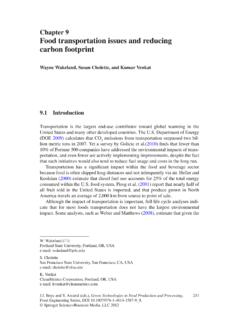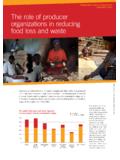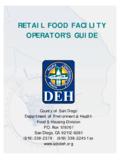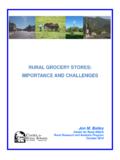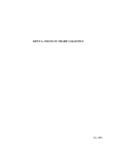Transcription of Advancing Sustainable Materials Management - …
1 Advancing Sustainable Materials Management : 2016 Recycling Economic Information (REI) Report October 2016 EPA530-R-17-0022016 EPA Recycling Economic Information (REI) Report 2 Background Sustainable Materials Management (SMM) refers to the use and reuse of Materials in the most productive and Sustainable way across their entire life cycle. On a broader scale, SMM looks at social, environmental and economic factors to get a more holistic view of the entire system. The benefits of maximizing this connection include conserving resources, reducing waste, slowing climate change, and minimizing the environmental impacts of the Materials we use. In an era of limitless business ingenuity and limited resources, the Sustainable Management of natural capital is increasingly a part of the international conversation about how to achieve economic growth without compromising human health and the environment upon which that growth depends. By looking across the life cycle, businesses can maximize the use of goods, while limiting the amount of material sent to landfills.
2 The 2016 Recycling and Economic Information Report aims to increase the understanding of the economic implications of material reuse and recycling. Additionally, the methodology provides a foundation for future work to expand the information and analysis on the economic aspects of Sustainable Materials Management . The 2001 National Recycling Coalition report, Recycling Economic Information Study laid the foundation for the methodology used to quantify the potential economic benefits of recycling, reuse and Since this landmark publication, significant changes have occurred regarding the scope and magnitude of recycling activities, their contributions to the national economy and the data and methodologies available to analyze economic activity attributable to recycling. The 2001 REI study acknowledged several challenges and limitations of the REI methodology, including the inability to isolate recycling activities within multi-faceted manufacturing sectors and the issue of double-counting inherent in the methods used.
3 Since 2001, other researchers refined the methodology to address some of these issues, but challenges remain. The 2016 REI report presents an alternative approach for measuring the economic activity associated with recycling and addresses uncertainties from the 2001 REI study. The 2016 REI report uses a Waste Input-Output (WIO) model built on the official Input-Output (IO) tables maintained by the United States Bureau of Economic Analysis, which describe the economic transactions between industries and are used to formulate monetary and fiscal policy. Currently, the official IO table shows flows of transactions between industries, but does not distinguish between recycling operations and recyclable material flows. Recyclable material flows include products and Materials which may be collected, processed and incorporated into another product for final or intermediate use. Recycling operations are the processes involved in the recycling of Materials or the use of recycled Materials in final or intermediate products.
4 Separating out the recycling activities is complicated because they are either embedded in the broader activities of a manufacturing sector or aggregated within the waste Management and remediation services industry. Therefore, to isolate the impact of recycling, EPA identified nine material sectors a priori, then developed a methodology to determine the presence of recycled content in final goods and the upstream impacts of the aforementioned recycled content. 1 Beck/NRC. (2001). Recycling Economic Information Study. Washington, DC: National Recycling Coalition (NRC). This report presents: An understanding of the importance of recycling s role to the nation s economy. A new methodology that addresses key areas of uncertainty in the 2001 REI study. A framework that can be updated with new Materials and data over time. 2016 EPA Recycling Economic Information (REI) Report 3 The 2016 REI report methodology improves upon the 2001 REI study and is able to model the impact of recycling while limiting the issue of double counting.
5 The 2016 REI report fills a gap in understanding material flows by establishing an analytical framework for estimating the broader environmental and economic impacts associated with recycling. A critical contribution of the refined methodology in the 2016 REI report is the development of a WIO model designed to capture the material inputs (production sectors like mining, energy, Materials , parts and products) and outputs (waste and material separation and reprocessing, of products, services and wastes). The WIO model includes the flow of goods and the flow of wastes. The information from the WIO model is cross-walked with separate data tables of taxes, wages and jobs to assess the impact of recycling activities within the economy. Additionally, the methodology in this report allows those with the relevant expertise to reproduce results through a transparent model. The methodology allows itself to ongoing improvement, as specific components of material flow estimation are constantly refined.
6 An additional benefit of this improved methodology is the ability for users to explore what if scenarios to examine potential impacts of a modified waste flow system. The data are then provided in such a way where each sector can be identified with direct, indirect and induced impacts. Scope and Definition of Recycling For the purpose of this analysis, recycling is defined as the recovery of useful Materials (such as paper, glass, plastic, metals, construction and demolition material ) and organics from the waste stream ( , municipal solid waste), along with the transformation of the Materials to make new products to reduce the amount of virgin raw Materials needed to meet consumer demands. The most significant structural change from the 2001 REI study is the incorporation of material transformation into the definition of recycling, allowing this model to capture the process influence from refurbishing or remanufacturing of goods, providing a more realistic scope of the entire process.
7 The 2016 REI report also considers the economic activity associated with the donation of edible food ( , canned goods nearing their expiration date). EPA recognizes that food donation and product reuse or remanufacturing are not recycling activities. However, the report uses the term recycling when describing the overall scope and results of the analysis. To estimate the economic activity attributable to recycling, it is necessary to associate recyclable Materials and recycling flows with the physical processes involved in transforming recyclable Materials into useful products, providing reusable Materials to intermediate and final consumers and delivering donated food to those in need. These processes can then be associated with specific product and service industries to estimate the direct, indirect and induced economic activity attributable to recycling, reuse and food donation. Recycling processes and activities include a range of activities including: (i) material collection; (ii) separation, cleaning and/or other processing ( , baling plastic bottles); (iii) transformation of recyclable Materials into marketable products; (iv) distribution, storage and service delivery ( , distribution of food to and from food banks); and (v) transportation between each stage.
8 For this analysis, recycling activities are defined to include all of these activities. The scope of recycling activities in this report does not include Materials that are recovered or reused during the initial production stage, but rather on Materials already distributed into the economy. However, to create an efficient analytical framework while avoiding the issue of double-counting, recycling activities were further distinguished as direct or indirect: Direct recycling activities are those associated with the actual transformation of recyclablematerials into marketable products such as the transformation of aluminum scrap into semi-fabricated products ( , ingots) in a secondary smelter. For reuse and food donation, therecycling activity is defined as the point for sale ( , where reused goods substitute for newgoods) or the point of service ( , where a food pantry provides donated food to those in need).2016 EPA Recycling Economic Information (REI) Report 4 Indirect activities associated with recycling, reuse and food donation include the activities involved in the value chain of the direct processes such as the collection, sorting and transportation of aluminum scrap to the smelter or the transportation of donated food from the food bank to the local food pantry.
9 Table 1 summarizes the Materials and types of recycling processes captured in the analysis, which formed the basis of the WIO model developed to estimate the economic impacts of these recycling activities. Table 1. Materials Included in the Scope of Recycling for the 2016 REI Report material Category material Subcategories material Description Example Recycling Processes Ferrous metals Iron Steel Ferrous metals recovered from appliances, automobiles, steel containers, construction and other sources Used as a feedstock in steel mills and foundries to manufacture raw steel and castings Aluminum No subcategories Aluminum scrap from used beverage cans, other containers, transportation, construction and other sources Used as a feedstock in smelting operations to manufacture semi-fabricated products ( , ingots, slabs) Plastics PET HDPE LDPE Recyclable plastics recovered for recycling Used in new food and nonfood packaging products Used in new rug fibers Used in new pipe products Use in new composite lumber Rubber Rubber crumb Other recyclable rubber Ground rubber produced from scrap tires used to produce rubber crumb and used in other scrap forms Used in new molded rubber products Used for playground surfacing and athletic fields Glass No subcategories Glass cullet recovered from glass bottles and jars Recovered cullet used in new glass containers Recovered cullet used in new fiberglass Paper Paper and newsprint Paperboard Recyclable paper and paperboard recovered and recycled Pulp from recovered paper products used in new paper products Construction and demolition (C&D)
10 material Concrete Asphalt pavement Asphalt shingles Gypsum wallboard Wood Recyclable Materials recovered from construction and demolition waste2 Recovered material used in road construction Recovered material used in new building products Electronics Computers Computer displays Hard copy devices Recyclable electronics that are recovered for refurbishing, remanufacturing or resale3 Refurbishing, remanufacturing and resale as substitute for new equipment 2 C&D metal waste is included in ferrous and nonferrous metals recycling analysis. 3 For the purposes of this analysis, electronics recycling includes the recovery, refurbishing/remanufacturing, and resale of electronics devices. It does not include the processing of used electronics into commodity-grade scrap, such as ferrous metals, nonferrous metals, glass, and plastic. To avoid double-counting, commodity-grade scrap is included in estimates of recycling of the respective commodity.










